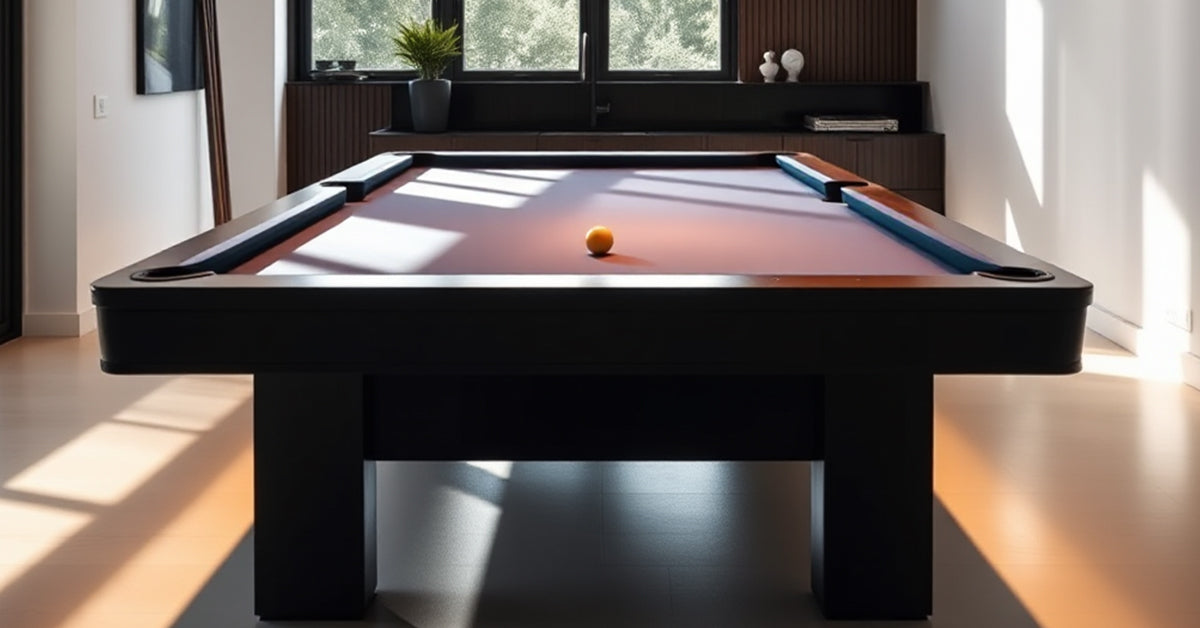Proper lighting is a critical yet often overlooked aspect of setting up a pool table. The quality and placement of lighting can significantly affect gameplay, visibility, and even the aesthetic appeal of your game room. This article explores how room lighting impacts pool table performance and provides guidance on achieving optimal illumination for an enhanced playing experience.
Why Lighting Matters in Pool
1. Visibility and Accuracy
- Ball and Pocket Visibility: Adequate lighting ensures that players can clearly see the balls, pockets, and table markings, which is essential for aiming and executing precise shots.
- Shadow Reduction: Proper lighting minimizes shadows on the table surface that can distort perception and affect depth judgment.
2. Player Comfort
- Eye Strain Prevention: Insufficient or harsh lighting can cause eye strain and fatigue, reducing concentration and enjoyment.
- Glare Minimization: Appropriate lighting reduces glare from the balls or table surface, which can be distracting and impact shot accuracy.
3. Aesthetic Enhancement
- Ambiance Creation: Well-designed lighting enhances the overall ambiance of the game room, making it more inviting and professional-looking.
- Highlighting the Table: Proper illumination draws focus to the pool table as the centerpiece of the room.
Key Lighting Considerations
1. Light Placement
- Overhead Positioning: The primary light source should be directly above the center of the pool table to provide even illumination across the playing surface.
- Height Adjustment: Lights should be hung at an optimal height, typically 32 to 36 inches (81 to 91 cm) above the table surface, to balance brightness and minimize glare.
- Coverage Area: Ensure the light fixture spans the length of the table to illuminate all areas equally. Multi-shade fixtures are often used for this purpose.
2. Light Quality
- Brightness Levels: Aim for a brightness of around 60 to 70 foot-candles (645 to 753 lux) on the table surface for optimal visibility.
- Color Temperature: Use bulbs with a color temperature between 3000K to 4000K, which provides a warm to neutral white light that's comfortable for the eyes.
- Color Rendering Index (CRI): Choose bulbs with a high CRI (90+), which ensures colors appear natural and enhances visual clarity.
3. Light Fixture Selection
- Dedicated Pool Table Lights: Specialized fixtures designed for pool tables distribute light evenly and reduce shadows.
- Shade Design: Shades should direct light downward onto the table and prevent light from shining directly into players' eyes.
- Style and Material: Select fixtures that complement your room's decor, whether traditional, modern, or themed.
4. Eliminating Glare and Shadows
- Matte Surfaces: Use light fixtures and bulbs with matte finishes to reduce reflective glare.
- Avoid Shiny Objects: Minimize the presence of shiny surfaces around the table that can reflect light into players' eyes.
- Balanced Lighting: Incorporate ambient room lighting to reduce high contrast between the table area and surrounding space.
Types of Lighting Solutions
1. Traditional Billiard Lights
- Description: Often feature multiple shades (2 to 4) connected by a rod or chain.
- Advantages:
- Even light distribution.
- Classic aesthetic appeal.
- Considerations: Ensure the fixture is proportionate to the table size.
2. LED Lighting
- Description: Energy-efficient and long-lasting, LEDs offer consistent brightness and color temperature.
- Advantages:
- Low heat emission.
- Dimmable options for adjustable brightness.
- Considerations: Choose LEDs designed for high-CRI applications to enhance color accuracy.
3. Pendant Lights
- Description: Single or multiple hanging fixtures that can be customized in height and style.
- Advantages:
- Versatile design options.
- Focused illumination.
- Considerations: May require careful placement to ensure even coverage.
4. Track Lighting
- Description: Adjustable lights mounted on a track system, allowing for directional lighting.
- Advantages:
- Flexibility in light positioning.
- Modern aesthetic.
- Considerations: May create uneven lighting if not properly configured.
Room Lighting Tips for Optimal Performance
1. Match Fixture Size to Table Size
- 7-Foot Tables: Use fixtures that are 40 to 52 inches (102 to 132 cm) long.
- 8-Foot Tables: Fixtures should be 50 to 60 inches (127 to 152 cm) long.
- 9-Foot Tables: Opt for fixtures 60 to 72 inches (152 to 183 cm) long.
2. Use Dimmers
- Adjustable Brightness: Installing dimmer switches allows you to fine-tune the lighting intensity based on preference and time of day.
3. Incorporate Ambient Lighting
- Balance the Room: Adding floor lamps or wall sconces helps reduce contrast and prevents the pool table area from being too isolated in brightness.
4. Regular Maintenance
- Clean Fixtures and Bulbs: Dust and dirt can diminish light output, so clean your lighting fixtures regularly.
- Replace Burnt-Out Bulbs Promptly: To maintain even lighting, replace bulbs as soon as they burn out, preferably with bulbs of the same type and age.
Common Lighting Mistakes to Avoid
1. Insufficient Lighting
- Issue: Leads to poor visibility and increased eye strain.
- Solution: Ensure the light source provides adequate brightness and covers the entire table.
2. Overly Bright or Harsh Lighting
- Issue: Can cause glare and discomfort.
- Solution: Use diffused lighting and bulbs with appropriate brightness levels.
3. Improper Fixture Height
- Issue: Hanging lights too high or too low affects light distribution and can cause glare.
- Solution: Adjust fixture height to the recommended 32 to 36 inches above the table surface.
4. Ignoring Aesthetics
- Issue: Mismatched or unattractive fixtures can detract from the room's ambiance.
- Solution: Choose lighting that complements your decor and enhances the overall look of the game room.
The Impact on Gameplay
Proper room lighting directly influences:
- Shot Precision: Clear visibility allows players to accurately judge distances and angles.
- Game Pace: Comfortable lighting reduces fatigue, enabling longer, more enjoyable playing sessions.
- Fair Play: Even lighting ensures that all players have the same visual conditions, promoting fairness.
Conclusion
The impact of room lighting on pool table performance is significant and multifaceted. By investing time and resources into selecting and installing the right lighting, you enhance not only the functionality of your pool table but also the overall enjoyment of the game. Remember that the goal is to create a well-lit, comfortable environment that allows for optimal focus and precision.
Final Tips:
- Consult with lighting professionals or interior designers if unsure about the best lighting solutions for your space.
- Test different lighting setups to find what works best for your specific room and playing preferences.
- Don't overlook the importance of aesthetics; a well-lit and visually appealing game room adds value to your home and enhances the playing experience.
Feel free to reach out if you have any more questions or need further assistance with pool table lighting!


